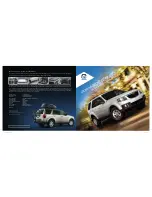
REPAIRS - WHEREVER POSSIBLE, SEE YOUR TIRE RETAILER AT
ONCE
If any tire sustains a puncture, have the tire demounted and thoroughly
inspected by a tire retailer for possible damage that may have occurred.
A tread area puncture in any passenger or light truck tire can be
repaired provided that the puncture hole is not more than 1/4” in
diameter, not more than one radial cable per casing ply is damaged, and
the tire has not been damaged further by the puncturing object or by
running underinflated. Tire punctures consistent with these guidelines
should only be repaired by following the Rubber Manufacturers
Association (RMA) recommended repair procedures. Plug-only repairs
done on-the-wheel are considered improper and therefore, not
recommended. Such repairs are not reliable and may cause further
damage to the tire.
STORAGE
Tires contain waxes and emollients to protect their outer surfaces from
ozone and weather checking. As the tire rolls and flexes, the waxes and
emollients continually migrate to the surface, replenishing this protection
throughout the normal use of the tire. Consequently, when tires sit
unused for long periods of time (a month or more) their surfaces
become dry and more susceptible to ozone and weather checking and
the casing becomes susceptible to flat spotting.
For this reason, tires
should always be stored in a cool, dry, clean, indoor environment.
If storage is for one month or more, eliminate the weight from
the tires by raising the vehicle or by removing the tires from the
vehicle. Failure to store tires in accordance with these
instructions could result in damage to your tires or premature
aging of the tires and sudden tire failure.
When tires are stored, be sure they are placed away from sources of heat
and ozone such as direct sunlight, hot pipes and electric generators. Be
sure that surfaces on which tires are stored are clean and free from grease,
gasoline or other substances, which could deteriorate the rubber. Failure to
store tires in accordance with these instructions could result in damage to
your tires or premature aging of the tires and sudden tire failure.
FOLLOW THESE MOUNTING RECOMMENDATIONS
Tire changing can be dangerous and must be done by professionally
trained persons using proper tools and procedures as specified by
the Rubber Manufacturers Association (RMA). Single or dual
assemblies must be completely deflated before demounting.
SAFETY INFORMATION
72
2013 Tire Warranty
(stn)
Supplement, 1st Printing, September 2012
USA
(fus)



































